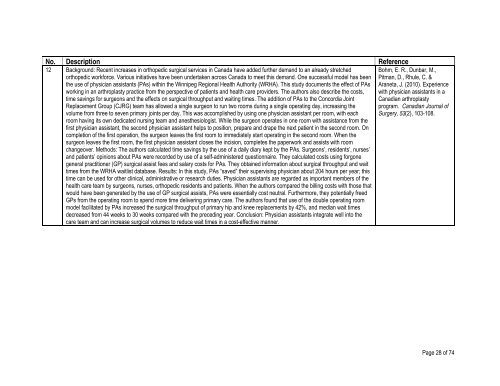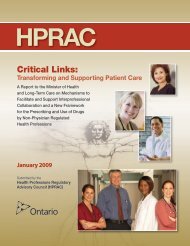Physician Assistants: A Literature Review - Health Professions ...
Physician Assistants: A Literature Review - Health Professions ...
Physician Assistants: A Literature Review - Health Professions ...
- No tags were found...
Create successful ePaper yourself
Turn your PDF publications into a flip-book with our unique Google optimized e-Paper software.
No. Description Reference12 Background: Recent increases in orthopedic surgical services in Canada have added further demand to an already stretchedorthopedic workforce. Various initiatives have been undertaken across Canada to meet this demand. One successful model has beenthe use of physician assistants (PAs) within the Winnipeg Regional <strong>Health</strong> Authority (WRHA). This study documents the effect of PAsworking in an arthroplasty practice from the perspective of patients and health care providers. The authors also describe the costs,time savings for surgeons and the effects on surgical throughput and waiting times. The addition of PAs to the Concordia JointReplacement Group (CJRG) team has allowed a single surgeon to run two rooms during a single operating day, increasing thevolume from three to seven primary joints per day. This was accomplished by using one physician assistant per room, with eachroom having its own dedicated nursing team and anesthesiologist. While the surgeon operates in one room with assistance from thefirst physician assistant, the second physician assistant helps to position, prepare and drape the next patient in the second room. Oncompletion of the first operation, the surgeon leaves the first room to immediately start operating in the second room. When thesurgeon leaves the first room, the first physician assistant closes the incision, completes the paperwork and assists with roomchangeover. Methods: The authors calculated time savings by the use of a daily diary kept by the PAs. Surgeons’, residents’, nurses’and patients’ opinions about PAs were recorded by use of a self-administered questionnaire. They calculated costs using forgonegeneral practitioner (GP) surgical assist fees and salary costs for PAs. They obtained information about surgical throughput and waittimes from the WRHA waitlist database. Results: In this study, PAs “saved” their supervising physician about 204 hours per year; thistime can be used for other clinical, administrative or research duties. <strong>Physician</strong> assistants are regarded as important members of thehealth care team by surgeons, nurses, orthopedic residents and patients. When the authors compared the billing costs with those thatwould have been generated by the use of GP surgical assists, PAs were essentially cost neutral. Furthermore, they potentially freedGPs from the operating room to spend more time delivering primary care. The authors found that use of the double operating roommodel facilitated by PAs increased the surgical throughput of primary hip and knee replacements by 42%, and median wait timesdecreased from 44 weeks to 30 weeks compared with the preceding year. Conclusion: <strong>Physician</strong> assistants integrate well into thecare team and can increase surgical volumes to reduce wait times in a cost-effective manner.Bohm, E. R., Dunbar, M.,Pitman, D., Rhule, C. &Araneta, J. (2010). Experiencewith physician assistants in aCanadian arthroplastyprogram. Canadian Journal ofSurgery, 53(2), 103-108.Page 28 of 74
















